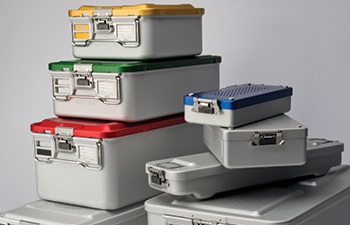Deciding on the right sterilization method for the appropriate surgical device has become a challenging quest. Increase in minimally invasive surgical procedures and the growth of more resistant microbes require greater diligence and team decision making when choosing a new sterilization system, including sealed containers.
This decision requires the joint efforts of healthcare managers, sterile processing technicians, OR staff, infection control personnel, physicians, materials management, and medical device manufacturers.
Issues of cost, ease of use, and rapid turnovers must be balanced with ethical concerns regarding patient care and safety. The need to sterilize instrument sets and medical devices rapidly has challenged our concept of adequate decontamination and sterilization procedures. Third party reprocessing has brought about questions of single-use devices. Are these items safe for multiple processing?
In terms of decontamination and sterilization, the margin of safety needs to be assessed as to which methods can ensure a greater level of sterility assurance for items particularly challenging to process.
Thus, it is the combined efforts of healthcare professionals and vendors working in concert to determine the appropriate sterilization process used with each sterilization container, wrap, and instrument set.
There is no question that certain materials, such as high-density polymers, and certain instruments, such as minimally invasive surgical devices, are a greater challenge to clean and sterilize. Furthermore, the barrier properties of the wrap/container to contain clean sterile instruments must be evaluated based on event-related factors.
Matching Materials to Sterilization Methods
In the past, sterilization containers and methods, such as ethylene oxide, were exempted from validation testing or reviewed by regulatory agencies with little relevant data.
In contrast, the latest systems have been subjected to lengthy reviews with endless requests for clarification and testing with the requirement of incremental validation below the half cycle parameters based on the overkill method, the norm for past sterility assurance and FDA pre-market clearance.
Thus, it is up to a team of decision makers to review the requirements of the facility when it comes to deciding on a new sterilization system. This should include data in relation to process, material and biological compatibility, durability, and adaptability.
Given the decline in healthcare reimbursement, there is no question that a tray system, used for various methods of sterilization and composed of reusable and adaptable components, is an advantage.

As instrument protection is a primary planning consideration for delicate or costly instrumentation, the team should devise a strategy that includes steps for customization of various instrument trays based on need assessment.
In doing so, the advantage of standardization and simplification of instrument sets in cost savings from repair and replacement, as well as a reduction in excess inventory can justify the initial expense of a container system.
The team should evaluate current repair and replacement expenses along with the costs of disposable wrap. All medical devices require wrap or sealed containers for the protection of instrument sets from environmental factors.
The time to wrap, material costs over time, tape, labor and expenses related to reprocessing must be included in the evaluation procedure. A sealed container is virtually impossible to penetrate or puncture. If the filter is protected by an offset retention plate, the assurance of safety is enhanced and chance tampering is further reduced with the use of a tamper-evident seal.
Practical Considerations for Container Use
As sterility is a statistical concept; a major goal is to review the manufacturer’s instruction manual for proper care and handling as well as process information. Request current validation testing information.
Has the sterilization container been validated using the newer methods of sterilization? Has the manufacturer undertaken an event-related study? How secure is the seal? How well will the container allow for sterilization of blades and lumens? How durable is the product? Is the container dry?
Plastic sterilization containers have a history of problems with wet packs because of the accumulation of condensate on the internal and external surfaces of the case after the sterilization process has been completed. As a result, some manufactures have added metal inserts or incorporated metal parts or a composite material of plastic and metal in the case design.

Moisture has always been considered a breeding ground for bacteria, although the inside of the container should be free of microbes after sterilization. In addition, condensate accumulation causes technical and quality assurance questions for the processing team and a lower expectation of sterility assurance.
As a result of wet packs with flash sterilization, a processed instrument must be used immediately after this method. In Australia and countries in Europe, flash sterilization has been banned entirely. Pre-vacuum steam sterilization is the method of choice for rapid sterilization.
Wet packs are a problem with some metal container systems as well. In the past, an absorbent towel had been used to absorb moisture and to protect instrumentation. If the purpose of the towel is to provide protection, examine other options including instrument mats that provide drainage or instrument baskets with secure adaptable inserts.
If the sterilization container requires a towel because of moisture, check to see if the sterilizer is properly functioning and that parameters for dry time have been met.
-
Product on sale
 Become TORG PartnerOriginal price was: €80.00.€70.00Current price is: €70.00.
Become TORG PartnerOriginal price was: €80.00.€70.00Current price is: €70.00. -
Product on sale
 Option 2 NMBI MentoringOriginal price was: €75.00.€67.00Current price is: €67.00.
Option 2 NMBI MentoringOriginal price was: €75.00.€67.00Current price is: €67.00. -
Product on sale
 Option 1 NMBI MentoringOriginal price was: €55.00.€48.00Current price is: €48.00.
Option 1 NMBI MentoringOriginal price was: €55.00.€48.00Current price is: €48.00. -
Product on sale
 RCSI FNM Aptitude Test Preparatory Course EnrolmentOriginal price was: €90.00.€80.00Current price is: €80.00.
RCSI FNM Aptitude Test Preparatory Course EnrolmentOriginal price was: €90.00.€80.00Current price is: €80.00.
Some containers are designed with a greater ability to conduct heat than others, thus an assessment of the design of a particular container should be reviewed by the team for the purpose of determining the probability of wet packs.
More importantly, invite a representative from the company to meet with the team to answer questions and demonstrate effectiveness of the tray system in your sterilizer.
Wrap It up
Wrap, whether disposable or linen, is inconsistent from hospital to hospital. Some use various layers and brands while others mix cloth and non-woven polypropylene disposable wrap. Without wrap standardization, this means your load is inconsistent.
By placing products only in containers and metal trays compatible with load content and materials, most of the variables are controlled. In this way, healthcare facilities will increase the probability of having a sterile set at the OR site.
Healthcare staff from the OR and SPD have recognized the need for sealed containers and highly perforated metal trays long before many of the major medical companies began providing custom trays for instrument sets and implants.
Recently, several hospitals have explored ways to place their custom plastic trays in metal trays and containers. In the New York metropolitan area, Mercy Hospital on Long Island and Englewood Hospital in New Jersey requested a conversion from plastic trays and custom metal wrap cases, provided by several orthopedic manufacturers, to perforated metal trays and sealed containers.
Why would the hospital spend this extra money to replace a product in some cases provided with the instrumentation or implant? According to Marge Kulesa, RN, orthopedic nurse clinician, “I believe in the long run it is a cost saving in personnel because it decreases the need for wrapping and the time and cost involved in the wrapping of the tray.
It is so easy to use and there are no rips in the wrapping. There has been an increase in staff and nursing satisfaction as the instruments are sterile.”
Conversion to a sealed container system must be viewed as a significant advantage over a wrap tray. First, over time, sealed containers save time and dollars associated with wrapping. Secondly, the healthcare team could avoid reprocessing trays with torn wraps discovered upon inspection or at the last minute in the OR.
Thirdly, orthopedic devices represent the greatest challenge for transport and handling due to the weight/mass. A wrapped case, even one with product information, is a challenge to identify properly as to top and bottom.
Sharp edges on the tray or case can tear the wrap causing lost time in the surgical suite and reprocessing delays. This is especially true of plastic cases as they become brittle and break in the corners.
Handling and transporting heavy orthopedic trays create further challenges. Once they are wrapped, heavy cases have no handles. Furthermore, the wrap itself obscures any written information about the contents.
A sealed container has handles and identification such as engraved or silk-screened labeling. Many healthcare facilities have instituted a bar code tracking system, and a well-designed case system provides a location for that.
Since most orthopedic cases require many containers, a case cart can be used to transport the bulky orthopedic sets to the OR. Specially designed case carts with bays for sealed containers can decrease the need for shelf space and aid in transporting surgical devices.
“An unclean item used in surgery is as dangerous as a loaded gun,” says Bertha Litzky, PhD, microbiology. Most healthcare workers recognize the importance of properly and expeditiously cleaning surgical devices. Not only instrumentation but also sterilization case systems must be easy to clean.
Furthermore, sterilization itself is a risky business, as nocosomial infections remain a serious healthcare concern. There are no absolute rules when it comes to sterility assurance: sterility is a statistical concept. Healthcare workers and manufacturers need to join together to provide solutions for the sterilization of medical devices.
This team should evaluate the cost savings associated with the use of sealed containers, such as avoiding the additional expense of linen or disposable material, reprocessing, and labor to wrap trays at their site when considering the cost involved in the purchase of sealed containers. This does not include the cost of replacing torn wrap or the repair or replacement expense of damaged instruments or the loss of time due to inadequate labeling.
Nancy Chobin, RN, clinical educator, has recognized the need to standardize and simplify instrument sets using a team approach. “Sooner or later hospitals are going to find out that garbage in, garbage out–the way nurses are coming in and out. We have all these traveling people.
They don’t know our systems. The doctors get frustrated because the nurse doesn’t know what he wants, and it sets up a vicious cycle.” Our primary concern as healthcare providers and medical device manufacturers must be the need to deliver proper quality care with the greatest margin of safety for the patient rather than worrying about the cost to our immediate bottom line.
By Marcia Frieze, MS, and Kerrye Allen, RN
Marcia Frieze, MS, is the CEO of Case Medical, Inc. (Ridgefield, NJ) and Kerrye Allen, RN, is the OR and CS Manager at the University of Tennessee, Bowld.

